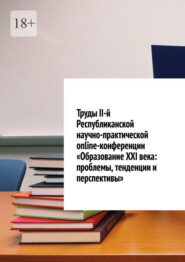По всем вопросам обращайтесь на: info@litportal.ru
(©) 2003-2024.
✖
Труды IV Республиканской научно-практической online-конференции «Образование XXI века: проблемы, тенденции и перспективы»
Настройки чтения
Размер шрифта
Высота строк
Поля
26. Suplicz, S. What makes a teacher bad? Trait and learnt factors of teachers’ competencies. Acta Polytechnica Hungarica, 2009, No. 6, P. 125—138.
27. Sаnchez, M. M., Pecino, R. M., Rodr?guez, Y. T., & Melero, P. T. Student perspectives on the university professor role. Social Behavior and Personality: An International Journal, 2011, No. 39, P. 491—496. doi:10. 2224/sbp.2011.39.4.491
28. Brophy, J. Conceptualizing student motivation. Educational Psychologist, 1983, No. 18, P. 200—215.
29. Fisher, C., Berliner, D., Filby, N., Marliave, R., Cahen, L., & Dishaw, M. Teaching behaviors, academic learning time, and student achievement: An overview. In C. Denham
& A. Lieberman (Eds.), Time to Learn. Washington, D.C.: National Institute of Education. 1980.
30. McIntyre, D.J., Copenhaver, R.W., Byrd, D.M., & Norris, W.R. A study of engaged student behaviour within classroom activities during mathematics class. Journal of Educational Research, 1983, No. 77 (1), P. 55—59.
31. Astin, A. Student involvement: A developmental theory for higher education. Journal of College Student Development. 1984, No. 25, P.297—308.
32. Kuh, G. D. What we’re learning about student engagement from NSSE: Benchmarks for effective educational practices. Change, 2003, No. 35 (2)..
33. Handelsman, M. M., Briggs, W. L., Sullivan, N., & Towler, A. A measure of college student course engagement. Journal of Educational Research, 2005, No. 98, P. 184—191.
34. Chapman E. Alternative approaches to assessing student engagement rates. Practical Assessment, Research & Evaluation, 2003, No. 8. Retrieved from http://pareonline.net/getvn.asp?v=8&n=13
35. Franklin, E.E. Assessing teaching artists through classroom observation. Teaching Artist Journal, 2005, No. 3, P. 148—157
36. Krause, K.L. and Coates, H. Students’ Engagement in First-Year University. Assessment & Evaluation in Higher Education, 2008, No. 33, P. 493—505. https://doi.org/10.1080/02602930701698892
37. Kiefer, S., and Pennington, S. Associations of teacher autonomy support and structure with young adolescents’ motivation, engagement, belonging, and achievement. Middle Grades Res. J. 2017, No. 11, P. 29.
38. Cinches, Ma. Florecilla & Russell, Ruth Love & Chavez, Judith & Ortiz, Rosella. Student engagement: Defining teacher effectiveness and teacher engagement. Journal of Institutional Research South East Asia. 2017, No. 15. P. 5—19.
39. Suldo, Shannon & Friedrich, Allison & White, Tiffany & Farmer, Jennie & Minch, Devon & Michalowski, Jessica. Teacher Support and Adolescents’ Subjective Well-Being: A Mixed-Methods Investigation. School Psychology Review. 2009, No. 38, P. 67—85. 10.1080/02796015.2009.12087850.
40. Spilt, Jantine & Hughes, Jan & Wu, Jiun-yu & Kwok, Oi-Man. Dynamics of Teacher—Student Relationships: Stability and Change Across Elementary School and the Influence on Children’s Academic Success. Child development. 2012, No. 83. P. 1180—95.
10.1111/j.1467—8624.2012.01761.x.
41. Zepke, N., L. Leach, & P. Butler. Student engagement: What is it and what influences it? Wellington, Teaching and Learning Research Initiative. 2010. http://www.tlri.org.nz/sites/default/files/projects/9261-Introduction.pdf
42. Federici, R. A., & Skaalvik, E. M. Students’ perception of instrumental support and
effort in mathematics: The mediating role of subjective task values. Social Psychology of Education: An International Journal, 2014, No. 17 (3), P. 527—540. https://doi.org/10.1007/s11218-014-9264-8
43. Tennant B, Stellefson M, Dodd V, Chaney B, Chaney D, Paige S, Alber J. eHealth Literacy and Web 2.0 Health Information Seeking Behaviors Among Baby Boomers and Older Adults J Med Internet Res. 2015, 17 (3):e70
Karibayeva Lazzat
Challenges in Online Education in the Context of English Language Teaching and Learning
(Master student at Suleyman Demirel University)
Abstract
After sudden and abrupt changes due to the pandemic outburst during 2019—2021, many students and teachers had to experience all the benefits and drawbacks of remote study and work. Flexibility and easy access as opposed to the internet connection and technology failure, unfamiliar technological tools and the lack of personal communication were the issues that caused mixed perceptions towards studying under the conditions of being locked at home. This article seeks to explore the challenges that learners faced over the recent two years. However, apart from evaluating what issues are engendered by the exposure to distance learning, this paper addresses the challenges in learning English remotely by investigating and elaborating on solutions suggested by researchers in this area. The paper concludes by outlining recommendations for English language teachers to make the process of distance learning less challenging.
Keywords: online education, distance learning, student perception, challenges of remote learning, technology, TEFL (teaching English as a foreign language), traditional learning, face-to-face education, distance mode of teaching.
Introduction
Nowadays, various activities can be comfortably implemented via smartphone applications or numerous websites. In addition, reading books, searching for information, as well as socializing with peers, are likely to be readily accessible at any time on the screens of personal electronic gadgets. Not surprisingly, modern technology has impacted teaching practices which, in turn, have undergone significant transformations by relocating to web-assisted environments. In 2012, at a university lecture, professor Andrew Delbanco pointed out that «your French teacher may be a version of Siri on your smartphone». (Romeo, 2012).
Moreover, the years 2019 – 2021 witnessed unprecedented growth in the number of virtual courses and lessons conducted by school teachers and university professors. The sudden increase was directly linked to the compelled transition to the distant mode of teaching. Although online learning seems still to be demanded, some experts, educators, and learners claim that e-learning is not as effective and engaging as brick-and-mortar classrooms (Irfan & Iman, 2020). Therefore, it is important to compare whether more preference is still given to face-to-face education alongside consideration of challenges that learners encounter while studying online. In the light of the recent growth in the demand for online teaching, a great majority of young individuals may have changed their attitudes, shifting positively or negatively, towards remote classes. In particular, learning a foreign language may even be challenged due to the lack of real-time, face-to-face interaction with a person since communicative practice is likely to be affected by the inconveniences of an online learning environment.
The value of this study will be in obtaining empirical data which will help to explore the factors that English language learners found as crucial and beneficial for achieving academic success, or insufficient and undesirable in the course of distance education.
Literature Review
Kazakhstan was not the only country to switch to distance education; it was, in fact, a worldwide trend. These trends indicate that learners in Kazakhstan and worldwide have to adapt to the new realia and developments. Since the success of education often depends on the overall perception of course participants, Allen and Seaman (2013) were focused on establishing learners’ judgment of distance education which was described as a positive experience by only a half of the respondents which implies that almost 50 percent of the other enrollees remained unsatisfied. Consequently, a significant number of online learners could not have fully achieved the expected learning outcomes. Although the course content and learning outcomes were noted to be relevant as compared to the traditional classroom, Allen and Seman’s (2013) research found the aspects that caused barriers in academic studies. Remote classrooms might not suffice to encourage learners’ dedication to their studies or progress in their knowledge and abilities. Instead of being active participants, those being educated online might only remain passive listeners. These are some of the reasons why some students ranked online classes lower than traditional classrooms. This means that despite the comfort and accessibility of online instruction, learners find traditional classrooms more enjoyable or constructive.
Recent research by Alawawdeh and Alshtaiwi (2020) points out that «many issues arise from teachers, learners, and the learner’s social environment». The authors argue that «online education is not going well as it lacks planning and preparation». Planning and preparation, in turn, are defined as required to enhance online learning; the rationale behind this is that distance learning needs more time and effort on the part of teachers and learners to make it «function exactly as intended». Based on the research studies, Alawawdeh and Alshtaiwi’s (2020) claims are justified in demanding that teachers should be qualified and trained to revitalize and enrich the teaching methods with proper knowledge and skills. As for students, they should be expected to be educated by an expert to improve ICT (information and computer technology) skills and overcome challenges related to distance education. It was fair to mention that the families of the students should be involved to assist and help their children with technology. Despite the high rates of online course enrollment and a substantial amount of positive feedback, the lack of electronic equipment, or stable internet connection were found to be critical yet due to financial shortages in the families (Alawawdeh & Alshtaiwi, 2020).
On the other hand, negative judgments of distance learning may arise due to bias such as preferred learning styles or a common misconception of virtual classes. Nguen (2015), having examined the efficiency of e-learning, argues that traditional classes, as well as online classrooms, are both effective methods. The author suggests that face-to-face education is starting to lose its hegemony on the market. The rationale for such a development is found to be cost-effectiveness while the cost of offline education is rising dramatically. In addition, access to world-class education alongside classroom size possibilities are significant benefits of online learning.
Conclusion
Having reviewed some recent research publications in the field of online education and language learning, the following conclusions have been derived. First of all, there are both significant benefits, as well as drawbacks to learning English in the context of online education (Appana, 2008). Accessibility, cost-effectiveness, and schedule convenience are some of the aspects that attract students to online learning. At the same time, insufficient discipline, motivation, and digital illiteracy tremendously impart the perception of and the outcomes of virtual classes. Based on the findings discovered, the following recommendations should be observed to soothe the undesired effect of e-learning (Alawawdeh & Alshtaiwi, 2020).
References
Alawawdeh, N. & Alshtaiwi, M. (2020). Foreign Languages e-learning: Challenges, Obstacles and Behaviors during Covid-19 Pandemic in Jordan. PalArch’s Journal of Archeology of Egypt/Egyptology 18 (6): 536—554 10.13140/RG.2.2.34688.87048
Allen, I. E., & Seaman, J. (2013). Changing course: Ten years of tracking online education in the United States. Babson Park, MA: Babson Survey Research Group and Quahog Research Group, 3—6. https://files.eric.ed.gov/fulltext/ED541571.pdf
Appana, S. (2008). The online learner: A Review of Benefits and Limitations of Online Learning in the Context of the Student, the Instructor, and the Tenured Faculty. International Journal on E-learning Contemporary Issues in Technology and Teacher Education, 7 (1), 5—22 https://www.researchgate.net/publication/237143888_A_Review_of_Benefits_and_Limitations_of_Online_Learning_in_the_Context_of_the_Student_the_Instructor_and_the_Tenured_Faculty
Charles, S., Malek H., & William, M., (2019). A Preliminary Study of Students Perception and Learning from Different Methods. Journal of Academy of Educational Leadership. 23 (2), 3—5. https://www.abacademies.org/articles/a-preliminary-study-of-students-perception-and-learning-from-different-delivery-methods-8235.html
Moldazharova Nessibeli
MODERN TOOLS AND QUALITY MANAGEMENT METHODS OF SERVICE IN THE SYSTEM OF HEALTH TOURISM
(Scientific supervisor: Elmira Auezova, PhD, Gulzhahan Omarova, professor NCJSC «Semey medical university», Semey)
In the 80s of the last century, foreign scientists began to deal with the problem of quality of services. Two leading scientific schools of service marketing have been formed: the American school, represented by the works of L. Berry, A. Parasuraman and V. Zeitaml, and the Scandinavian school, which is made up of scientists from Finland and Sweden. American researchers have developed a methodology for continuous measurement and improvement of service quality. The methodology used for this was named SERVQUAL. The Scandinavian school introduced the concept of a two-factor quality model – functional and technical quality. The quality of service is created in the process of interaction between the consumer and the performer. The goal of the contractor is to create and maintain service quality standards. The main factor is the service processes of service quality and the behavior of staff. It is important not only what the vacationer receives in the service process – technical and technological quality, but also how this process occurs and is transformed into functional quality. At the same time, the staff must be motivated for high-quality service standards. American school use the SERVQUAL methodology as a universal tool for measuring the quality of service. American scientists believe that the quality of service is the result of comparing customer expectations regarding the quality of services and the impression of real services received. In recent years, in the domestic literature in various sectors of the economy, the assessment of the quality of services has become increasingly an object of consideration: scientific and methodological foundations for assessing the quality of services are being developed, models and methods of the service process focused on customer expectations, as well as issues of management and organization of services. Researchers pay special attention to the development of the service sector and the quality of services in the hospitality industry, service standards in the health resort sector.
The mechanism for introducing an intracorporate standard is a method for measuring the quality of health resort services and innovative service processes that affect service quality indicators. Internal corporate quality standard service in the sanatorium and resort area is a factor model that functionally allows you to most fully and timely provide vacationers with a complex service and health-improving services, characterized by qualitative and quantitative parameters, where the quality of service and the organizational service process are system-forming.
A service, unlike a product, is intangible. The service and its quality characteristics are inseparable in the service process, they are produced and consumed at the same time, they do not require system repair, storage. Service characteristics, measurement tools and service quality control require an original and unique approach.
Consumer satisfaction with health resort services is a key part of the study. The pricing strategy for wellness services is usually set by management, should attract vacationers, willing to pay the said price. While price defines the specialization of holiday needs, it is also an indicator of service quality, comfort level, and market segment in which the brand is located and competes with other resorts.
Effective resort revenue management should be based on key information sources of valuable information, consumer behavior of the target group, the results of systematic monitoring of service quality, volume of sales of the sanatorium-resort product. Development of a management strategy for a unified system of quality control of service, pricing, which is a backbone in the formation of a product (health, animation, excursion programs) that meets the needs of vacationers, is being created greater demand and, as a result, an increase in income. This leads to the assertion that revenue management is the process of maximizing profits from the sale of perishable resources, such as spa catering services, through price management, service quality, and service improvement through systematization.








